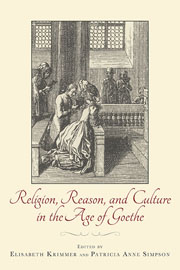Book contents
- Frontmatter
- Contents
- Acknowledgments
- Introduction
- I Wieland and Herder
- II Schiller and Goethe
- III Kleist and Hölderlin
- IV Leibniz, Spinoza, and Their Legacy
- 9 Leibniz Reception around 1800: Monadic Vitalism and Aesthetic Harmony
- 10 “The Magic Formula We All Seek”: Spinoza + Fichte = x
- Notes on the Contributors
- Index
10 - “The Magic Formula We All Seek”: Spinoza + Fichte = x
from IV - Leibniz, Spinoza, and Their Legacy
Published online by Cambridge University Press: 05 December 2013
- Frontmatter
- Contents
- Acknowledgments
- Introduction
- I Wieland and Herder
- II Schiller and Goethe
- III Kleist and Hölderlin
- IV Leibniz, Spinoza, and Their Legacy
- 9 Leibniz Reception around 1800: Monadic Vitalism and Aesthetic Harmony
- 10 “The Magic Formula We All Seek”: Spinoza + Fichte = x
- Notes on the Contributors
- Index
Summary
Sed omnia praeclara tam diffidila, quam rara sunt.
[For all excellent things are as difficult as they are rare.]
—Spinoza, EthicsThe Revolutionary Rhizome
All eyes, it would seem, are on Spinoza at the moment. Much of the credit for this remarkable renaissance is due to Gilles Deleuze, who wrote two books on Spinoza, and then went even further in his best-selling manifesto What Is Philosophy?, anointing Spinoza both the “prince” and the “Christ” of philosophy. And Deleuze is hardly alone in his attentions. Spinoza now looms large in our understanding of the entire Age of Goethe. The controversy over Spinoza still figures as a minor flap in Lewis White Beck's classic history, Early German Philosophy; but it has become the defining intellectual controversy of the whole age since the publication of Frederick Beiser's influential study The Fate of Reason in 1987. Further, over the past decade, the intellectual historian Jonathan Israel has published three massive tomes asserting that, basically, every significant thinker of the Enlightenment was a closet Spinozist. Skepticism may be in order: on Wall Street, this latest development would be read as a “contrary indicator,” signaling a market top. But the centrality of the Spinozastreit (Spinoza controversy) clearly means that we have to understand both the extent and the import of Spinoza's influence on the Age of Goethe. And the centrality of Spinoza to contemporary discourse is beyond doubt; somehow, he figures in everyone's equations.
- Type
- Chapter
- Information
- Religion, Reason, and Culture in the Age of Goethe , pp. 244 - 266Publisher: Boydell & BrewerPrint publication year: 2013

